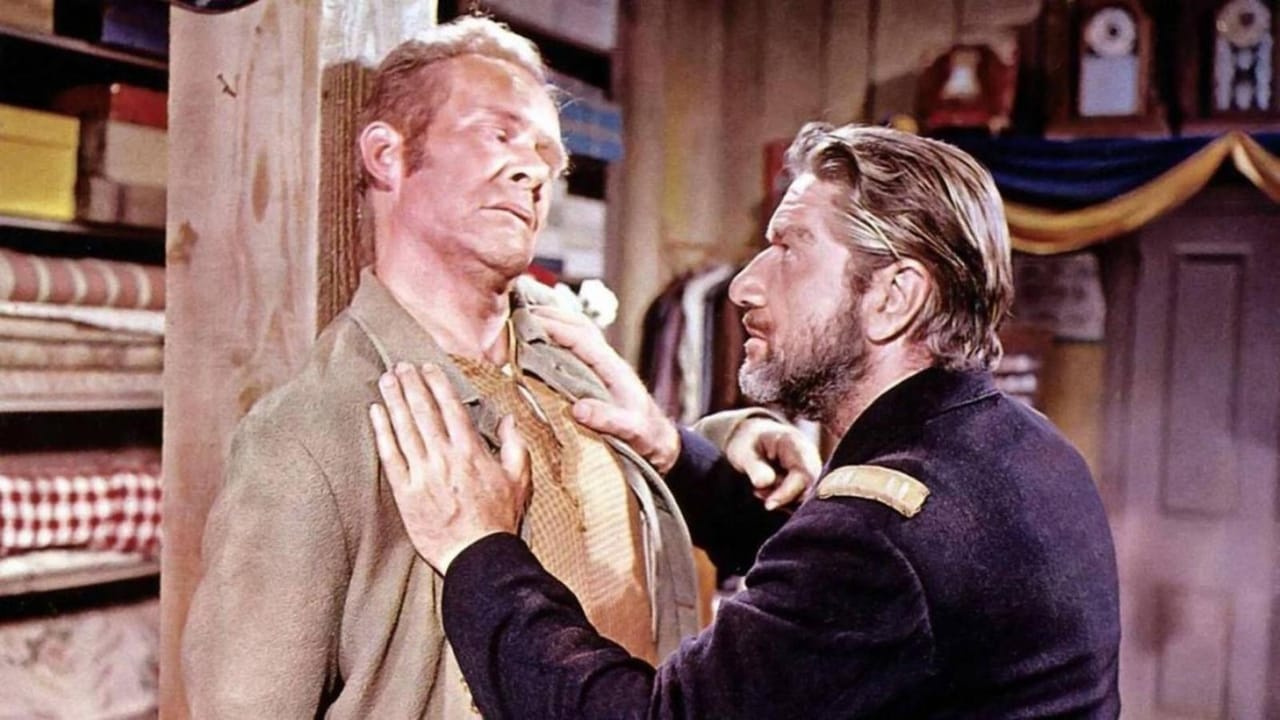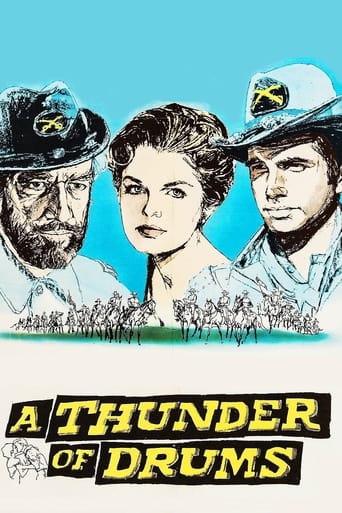

About the same time a cavalry lieutenant by the name of "Curtis McQuade" (George Hamilton) arrives at his new post in the desert a band of renegade Indians begin terrorizing the inhabitants of the area. But nobody knows for sure if these Indians are Comanche or Apache and until that question is answered any solution to the problem cannot be undertaken. But that isn't the only problem at this fort as Lt. McQuade also runs into his former girlfriend, "Tracey Hamilton" (Luana Patten) who just happens to be engaged to a fellow officer named "Lt. Thomas Gresham" (James Douglas). To further complicate matters, the commanding officer "Captain Stephen Maddocks" (Richard Boone) doesn't particularly care for Lt. McQuade and lets him know it right away. Anyway, rather than disclose the story and risk spoiling the film for those who haven't seen it I will just say that this was a pretty good western movie which tended to depict life at a frontier post in a less than favorable light. Although a couple of the actors could have used more screen time I liked the addition of Charles Bronson (as "Trooper Hanna"), Richard Chamberlain ("Lt. Porter"), and Arthur O'Connell ("1Sgt Karl Rodermill") along with the aforementioned George Hamilton and Richard Boone. In any case, I enjoyed this movie and rate it as slightly above average.
... View MoreGeorge Hamilton is an inexperienced lieutenant in the cavalry (!) newly assigned to a post under the command of the somewhat unkempt, but very savvy Captain Richard Boone. Hamilton was born in Comanche territory but is the son of a general and has spent some years in a comfortable post back East. He thinks he knows everything and is anxious to fight.He discovers that his former love, Luana Patton, is about to marry another officer. There are intrigues, involving Hamilton's making out with Patton behind her fiancé's back, and an attempt at blackmail by the uncouth Private Charles Bronson. Others in this pretty good cast include Arthur O'Connell, Slim Pickens, a young Richard Chamberlain, and Casey Tibbs, who may need Googling by those who have never heard of rodeos.There's a good deal of talk, interrupted by action episodes of some interest, and the dialog has the ring of authenticity. A cavalry patrol discovers two women raped and butchered by Indians, and an officer gives the order for "three married men" to dress the women for burial. When the three dismount they are ordered to hand the reins of their horses to the man to the right of them. That's a nicely observed detail. So is the fact that an unpleasant odor accompanies the transport of four dead bodies.Richard Boone, as the commanding officer, knows his business but he's stern and distant too. Nobody really gets close to him without being addressed as "Mister" and formally reprimanded for some minor infraction. Is this beginning to sound a little familiar? One of the sayings attributed to Boone is "never apologize, it's a sign of weakness." Honest.The similarities stem from the fact that the story was written by James Warner Bellah, a pulp writer who also produced the stories for John Ford's "Fort Apache," "She Wore A Yellow Ribbon," and "Rio Grande." James Warner Bellah was a neat writer, with a good deal of military experience behind him. His weakness as a writer was Manicheanism. The white cavalry, whatever its internal conflicts, is superior in every respect to the treacherous and faceless American Indians. It's really a retrograde assumption and has nothing to do with political correctness. The guy was a talented racist. On top of that, the officer corps is superior to the enlisted soldiers who live only to collect their pay and immediately get drunk and pass out.It wouldn't have taken much skill to turn this story into an involving saga of life in a cavalry outpost, with all its tribulations and its little rewards, to show some affection for the community. John Ford was able to do it -- three times. But director Joseph M. Newman opts to forget about a balanced, adult approach and hew to Bellah's dry and severe outline. It's all rather carelessly executed. All the officers except Boone have carefully styled and gelled hair. George Hamilton removes his cavalry hat and his hair is STILL flawlessly laid out across his scalp! The performances are all professional and the basic plot is interesting. It's too bad that so little imagination was invested in its execution. The absence of poetry is pretty nearly startling. What we wind up with is a talky picture about people we don't really care much about.
... View MoreJoey's comments above are spot on. And you should also notice the visual style of the film: scenes in the fort tend to be in tones of grey or blue, cavalry colours, but most scenes throughout the film have a detail picked out in bright red - clothing, books, drinks,and, finally blood. Compositions are also distinctive: two shots often have one figure closer to the camera, some medium shots have an over-the-shoulder angle. For those who like that kind of thing, there is an interesting Oedipal theme, and the film centres on the rite of passage of the central figure,played by George Hamilton, appropriately vain and self-regarding. Women are sacrificed and marginalised ruthlessly, and there is a further theme about children which I couldn't quite work out.The cavalry/Indians structure is the peg on which a thoughtful narrative has been hung; even the killing scenes avoid the some of current excesses, and there are hints that the Indians have their own culture which the cavalry officers learn to recognise - and exploit. The inferior technology of the Indians is clearly a factor in their defeat.It will be a shocking day when the US Cavalry meet an indigenous population which is tactically and technologically their equal, won't it?
... View MoreHas anyone noticed that almost every World War II movie had a triangle of two service men competing for the affection of one girl, with the world at war playing a minor role, usually to showcase the courage and nobility of our boys at war? Hollywood trotted out this formula once again for this movie, ruining an otherwise fine tale of soldiers on a far frontier battling a clever and determined enemy in a nasty little war, with no quarter asked or given. In the 60's there was no way a book was going to be brought faithfully to the screen. It had to be dumbed down, it had to devote an inordinate amount of time on the love interest, it had to be the equivilant of a "G" rating. A Thunder of Drums was an ass-kicking book, which failed as a film because although it managed to depart from romantic notions of war, still was unable to conceive of a story lacking romance. Even relatively recently, The Last of the Mohicans managed to have our frontiersman hero and a British officer competing for the affections of a girl. I am not saying there is no place for romance, but I am suggesting that some films would be better off without it, like A Thunder of Drums.
... View More